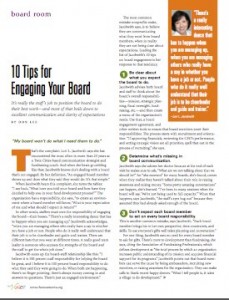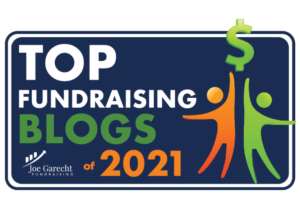An Excerpt from Don Lee of Chorus America’s Interview with Lori
These tips on engaging your board are drawn from a presentation I made at Chorus America’s 35th Annual Conference in Minneapolis, and a follow-up interview that became an article in the Chorus America magazine: The Voice.
Click to download a PDF of the entire interview
The most common mistake nonprofits make, Lori Jacobwith says, is to believe they are communicating what they want from board members, when in reality they are not being clear about expectations. Leading the list of Jacobwith’s 10 tips on board engagement is her response to that tendency.
1. Be clear about what you expect the board to do.
Jacobwith advises both board and staff to think about the board’s overall responsibilities—mission, strategic planning, fiscal oversight, fundraising, etc.—and then create a menu of the organization’s needs.
2. Determine what’s missing in board communication.
Jacobwith says she adores her doctor because at the end of each visit he makes sure to ask, “What are we not talking about that we should be?” An “aha moment” for many boards, she’s found, comes when they realize they haven’t talked about their role in raising awareness and raising money.
3. Don’t expect each board member to act on every board responsibility.
This is another common mistake, says Jacobwith. “Each board member brings his or her own perspective, time constraints, and skills. To use everyone’s gifts well takes planning and conversation.”
4. Be clear about what absolutely has to happen.
When she offers this advice, Jacobwith is thinking especially of small organizations. “I’ve been the only staff person three different times at small shops, with boards that had been around awhile. They had unbelievable expectations. It would have been impossible to do it all, so I had to get really clear about what tasks had to happen and what I needed their help with.
5. Equip board members to shine.
According to Jacobwith, the secret to fundraising is clear, bold communication. In order to be bold, and in order to be effective ambassadors, board members must know the organization, which means staffers must be strategic about channeling information to them.
6. Don’t be afraid to talk about the “funding gap.”
Surprisingly often in Jacobwith’s experience, board members are not accustomed to discussing whether revenue is keeping pace with expenses. She says sharing timely financial news, whether it’s good or bad, treats board members like insiders—which of course they are.
7. Identify key board members who can be your partners.
Although she believes planning a meeting ought to be like staging a performance, Jacobwith is not insisting that staff take center stage. That role, she says, is often better handled by a board member: a partner who delivers “the front-of-the-house message.”
8. To choruses: Tell your singers about opportunities to get more involved.
For choruses, singers represent a potent resource, a resource of a kind that few other nonprofits can claim. “The common denominator for people helping an organization succeed is passion,” says Jacobwith. “If I’m a singer, my passion quotient is really high.”
9. Have a conversation about accountability.
Once the board’s duties and responsibilities have been spelled out, members must commit to them. Establish a dashboard or some other means of monitoring performance and holding members accountable.
10. To board members: Don’t hold back.
“To really be clear, all of this is about communication,” Jacobwith says. Although she focuses on staff communication to the board, she tells board members they can’t simply sit back and wait for an invitation to engage. If they feel their time is not being used well, they ought to tell the board chair and staff about the skills they’d like to bring to the table.
Click here to download a PDF, so you can read Don Lee’s entire article and get more in-depth information about Engaging Your Board.
<






